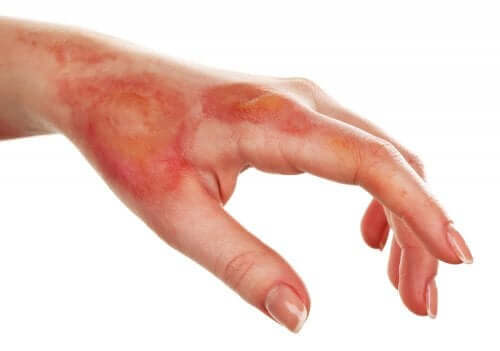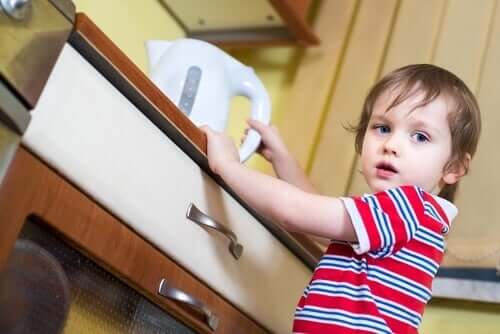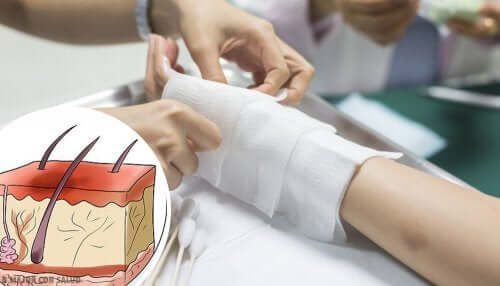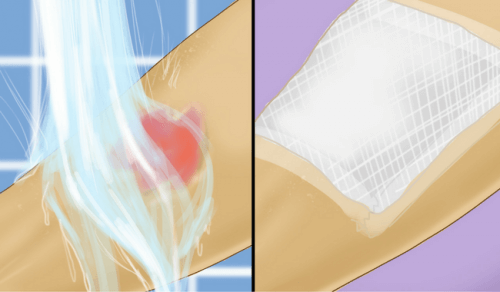How to Treat Burns in Children

We’ve all suffered a burn at some point. However, you may be wondering how to treat burns in children. Besides having a first-aid kit at home, there are certain steps and things to consider.
In this article, we’ll give you some basic tips on how to treat burns in children.
Burns

Burns are one of the most common household accidents. In fact, the groups that suffer more accidents of this type are housewives over 45, elderly people over 65, and, finally, children under five.
Therefore, it’s important to know how to treat burns in children.
Types of burns
Firstly, you must differentiate between the different types of burns. In fact, depending on their size, you’ll have to treat them in different ways.
First-degree burns
These burns involve only the epidermis – the outermost part of the skin. Although the skin reddens, no blisters appear. The most characteristic example are burns caused by sun exposure.
Second-degree burns
These burns affect the dermis and epidermis. Thus, in addition to skin reddening, blisters also appear. An example of second-degree burns are the classic burns when hot liquid falls on the skin.
We recommend you to read: How to Treat Burns with Home Remedies
Third-degree burns
Logically, these are the most dangerous burns. These burns affect all skin layers. In fact, they could even affect muscles, nerves, and bones. Third-degree burns char the skin, and, obviously, they require immediate medical attention.
Burns in children

Burns in children require medical attention when they’re extensive. In other words, if they affect more than 5% of the child’s body. In addition, regardless of the extent, you must take your child to the doctor in the case of second and third-degree burns.
However, according to their location, some burns should be examined by a doctor regardless of their degree:
- Burns on the face, hands, and feet
- Burns that cover joints
- If your child came into contact with high voltage
- If your child inhaled gases
How to treat burns in children

Some of the following tips will seem obvious, but there’ll be some that perhaps you didn’t know. In any case, they’re really useful and this protocol ensures the best treatment of burns in children.
- Firstly, remove the child from the source of the burn.
- Then, only remove clothing or accessories if they haven’t stuck to the skin. If they have, then leave them alone, as you may cause more damage by removing them.
- After that, cool the burn. To do this, put the affected area under running water for a few minutes. In this regard, it’s important for the water to be at normal temperature, not cold. Another option is to soak gauze pads with water or saline solution and put them on the burn.
- In addition, thoroughly clean the area with soap and water.
- Depending on the degree of the burn, you may have to take your child to the doctor. In case of sunburns, you can apply a moisturizing cream for a few days. However, deeper burns require medical attention. In these cases, the doctor may even prescribe an antibiotic ointment.
This article may interest you: Fenistil: A Great Remedy for Stings, Burns, and Hives
What not to do when it comes to burns in children

- Firstly, you shouldn’t apply ice or ice water directly on the burn. This is because it could cause even more damage.
- If there’s a blister, you mustn’t puncture it. On the contrary, you should leave it as is, otherwise you could cause an infection.
- Moreover, you shouldn’t give antibiotics to children without a medical prescription. Besides, they aren’t particularly indicated for burns.
- Finally, you shouldn’t apply talcum powder, butter, or toothpaste to the burn. Contrary to popular belief, applying these products could worsen the situation.
In any case, remember that a child’s skin is delicate. Even if the burns are only first-degree, if the pain is severe or persistent, then don’t hesitate to consult your pediatrician to rule out any major problems.
Moreover, never forget the importance of prevention. Although it’s impossible to foresee all household accidents, remember that, at the very least, you can keep certain safety measures to minimize the risk.
All cited sources were thoroughly reviewed by our team to ensure their quality, reliability, currency, and validity. The bibliography of this article was considered reliable and of academic or scientific accuracy.
- Castillo, P. (2018). Quemaduras. Conceptos para el médico general. Cuadernos de cirugía, 17(1), 58-63. http://revistas.uach.cl/pdf/cuadcir/v17n1/art10.pdf
- En familia AEP. (n.d.) Quemadura. Asociación Española de Pediatría. https://enfamilia.aeped.es/temas-salud/quemaduras
- Citores, A. P., & Pardillo, R. M. (2011). Tratamiento de las quemaduras en urgencias. Secciòn de urgencias, hospital universitario Gregorio Marañón. Madrid. http://www.enfermeriaaps.com/portal/download/URGENCIAS%20PEDIATRICAS/tratamiento_de_las_quemaduras_en_urgencias.pdf
This text is provided for informational purposes only and does not replace consultation with a professional. If in doubt, consult your specialist.








